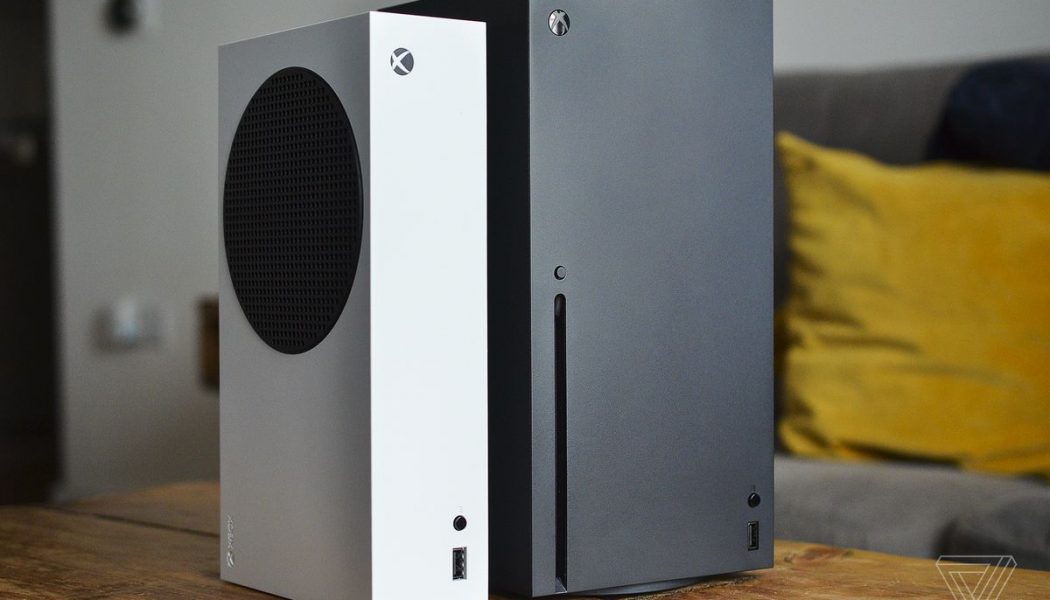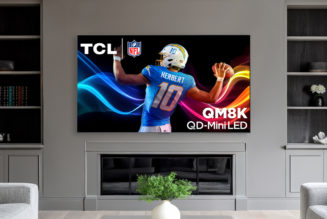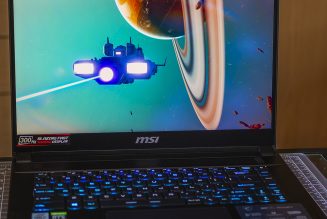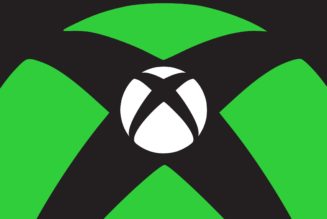Microsoft revealed its Xbox Series S console last week, aiming to offer more budget-friendly next-gen gaming for $299. The console is specifically targeted at 1440p resolution rather than 4K, leading to some lingering questions and confusion around just how well it will play next-gen games. There are concerns around the GPU performance, memory, and whether the Series S could hold back next-gen gaming. I got a chance to speak with Jason Ronald, Microsoft’s director of Xbox program management, to dig into what’s really going on with the Xbox Series S.
The biggest difference between the larger Xbox Series X and the Xbox Series S, apart from the size and design, is the GPU inside. The Xbox Series S has 4 teraflops of GPU performance, compared to the 12.15 teraflops on the Xbox Series X. The smaller console also has less RAM (10GB instead of 16GB) that also runs slower than the Series X. Other than that, the Series S runs the same Series X CPU at a slightly slower speed, and has 512GB of SSD storage instead of 1TB.
Some of the changes Microsoft has made to accommodate a cheaper Series S console have created a lot of debate around whether this console will hold back next-gen gaming in general. “Really bummed about this RAM situation on the Series S,” said Axel Gneiting, a principal engine programmer at id Software, in a now deleted tweet. “This isn’t easy to compensate and drags down base spec quite a bit for next-gen multi platform.”
:no_upscale()/cdn.vox-cdn.com/uploads/chorus_asset/file/21867253/twarren_200909_4177_0030.0.jpg)
Billy Khan, a lead engine programmer at id Software, shared Gneiting’s concerns. “The memory situation is a big issue on the S,” said Khan in another deleted tweet. “The much lower amount of memory and the split memory banks with drastically slower speeds will be a major issue. Aggressively lowering the render resolutions will marginally help but will not completely counteract the deficiencies.”
Sasan Sepehr, a senior technical producer at Remedy Entertainment, also shared a brief concern. “As a consumer, I love this,” said Sepher on Twitter. “As a Technical Producer, I see trouble.”
These concerns all seem reasonable. On paper the memory and GPU differences look like big gaps, but the reality is a little bit more complicated when you consider Microsoft is aiming for 1440p resolutions on Series S, not the 4K that the Xbox Series X is designed for.
“We did a lot of analysis of what it would really mean to run a game at 4K with 60fps and then to scale that down to 1440p at 60fps,” says Jason Ronald, Microsoft’s director of Xbox program management, in an interview with The Verge. “The reality is you don’t need as much memory bandwidth because you’re not loading the highest level MIP levels into memory. You don’t need the same amount of memory as well.”
Microsoft believes developers have a number of ways to build Xbox Series X games for 4K resolutions and then downscale them to 1440p for the Series S. “Developers have a whole host of different techniques, whether that’s changing the resolution of their title, things like dynamic resolution scaling frame to frame — that’s something we’ve seen a lot of adoption of, especially towards the end of this generation,” explains Ronald. “And obviously the ability to enable and display different visual effects, without actually implementing the fundamental gameplay.”
:no_upscale()/cdn.vox-cdn.com/uploads/chorus_asset/file/21865123/twarren_200908_4177_0006.0.jpg)
This is all particularly relevant when both consoles share almost identical CPU and I/O performance, something that has bottlenecked existing consoles. Microsoft focused on bumping the GPU performance with its Xbox One X, even using the 6 teraflops as a marketing point over the PS4 Pro’s 4.2 teraflops.
The Xbox One X was terribly bottlenecked at both the CPU and I/O level. Microsoft effectively shoved a more capable GPU inside a device still running a laptop-like CPU and a spinning hard drive. It just about managed 4K, but the CPU really held back a lot of games from reaching 60fps.
So how will the Xbox Series S compare to the older Xbox One X? It’s easy to look at the raw teraflops numbers and immediately think 6 teraflops is better than 4 teraflops, but it’s more complicated than that. The Xbox Series S runs AMD’s latest RDNA 2.0 architecture, while the Xbox One X was based on AMD’s older GCN architecture.
“With RDNA 2 we get basically a 25 percent performance uplift over GCN with no work by developers at all,” claims Ronald. “There’s a significant amount of efficiency we’re getting out of RDNA2 relative to GCN. Then we look at other things like using float 16 or variable rate shading, and we’re seeing on the order of 10-20 percent performance benefits from there as well.”
That should mean raw GPU performance on the Xbox Series S is similar to the Xbox One X, but the target resolution is 1440p instead of 4K. This is why the Xbox Series S will play games designed and enhanced for the bigger Xbox Series X, alongside Xbox One S versions of games that haven’t been tweaked instead of Xbox One X enhanced titles.
:no_upscale()/cdn.vox-cdn.com/uploads/chorus_asset/file/21865110/twarren_200908_4177_0026.0.jpg)
“It is really difficult to compare raw numbers like teraflops across generations, because we think about them differently,” says Ronald. “In general on the GPU side the Xbox Series S is effectively the same performance as an Xbox One X GPU, but it brings all the next-gen features like ray tracing, VRS, mesh shaders, and obviously when you look at the massive leaps in CPU performance and I/O performance, that’s why Xbox Series S is designed to deliver that true next-gen experience just targeting a lower resolution than Xbox Series X.”
The CPU improvements and addition of an SSD for the Xbox Series S will mean games can run a lot more smoothly than they ever did on the Xbox One X. “There are also opportunities where we can enhance the titles on Xbox Series S even further than what we can do on Xbox One X,” says Ronald. “If you look at the raw power of the Xbox Series S, if a title wants to go in and double its frame rates it’s actually really easy, because we’ve more than doubled the GPU performance and more than doubled the CPU performance, so it’s relatively easy for a developer to go in and enable that if they choose to update their title.”
Microsoft has certainly changed its focus for this generation of Xbox consoles to be more about frame rates and load times, rather than just graphical improvements alone. 4K is supported on the Xbox Series S through upscaling, and Microsoft is doing work at the display controller level to get higher image quality and improved color correction for crisper and more accurate images when games are being upscaled.
There’s no real big focus or guarantee of 8K for the Xbox Series S or Xbox Series X, which is a good thing. Consoles have promised 1080p or 4K performance before and failed to hit high framerates for smooth gameplay. “Historically, console generations have really been defined by how games look,” says Ronald. “This generation a lot of it is going to be how do they feel? How do they play? When you think about these large open worlds and keeping players immersed in it, I don’t want pop in, I don’t want load times.” Ronald says buttery smooth gameplay is going to be a priority for Microsoft over the generation of both of these consoles.
Microsoft is also relying on a technique called sampler feedback streaming in the Xbox Series S and X to improve the efficiency of SSD bandwidth. Sampler feedback streaming gives developers much more control over how data is delivered to the GPU for rendering, meaning only the textures that a GPU needs for a scene will be loaded into memory. This should provide some significant performance enhancements alone.
:no_upscale()/cdn.vox-cdn.com/uploads/chorus_asset/file/21865122/twarren_200908_4177_0007.0.jpg)
“When we think about the Xbox velocity architecture or sampler feedback streaming, those are areas where we expect a lot of innovation over the generation,” explains Ronald. “With something like sampler feedback streaming, it can deliver performance well beyond the raw hardware specs itself. So much of this generation is about efficiency.”
So will this Xbox Series S actually hold back next-gen games? Probably not. “No it’s not [going to hold back next-gen],” says Gavin Stevens, co-owner and design lead of indie studio Team Blur Games. “Anybody with even a little experience will tell you as such.” The reality is that the Xbox Series S will require developers to balance and scale their games just like many already do across a choice of hardware for PC gaming, and existing Xbox and PlayStation consoles.
There’s also the reality of existing consoles like the Xbox One and PS4 that could impact future games, since unlike the Xbox Series S there are serious CPU constraints to work around. Microsoft has promised that Xbox Game Studios titles due for release “in the next couple of years” will also be available on Xbox One. Sony on the other hand seemed like it was focused on exclusive games for the PS5 like Marvel’s Spider-Man: Miles Morales and Horizon Forbidden West, but the company is now also launching these on the PS4. Ratchet & Clank: Rift Apart isn’t on the list for a PS4 version, and it looks like a game that really takes advantage of the PS5’s SSD and would be challenging to get running on PS4 hardware.
Many of the hardware and efficiency improvements will need developers to really take advantage of them. While there might be concerns over some of Microsoft’s choices, it’s going to take some time before we see developers get to grips with hardware changes and optimize games accordingly. That’s how console generations have always worked.
The difference in this generation is that if Microsoft’s promises for the Xbox Series S and X hold true, we could be looking at a console period that truly favors framerates and visual quality over pure resolution. The Xbox Series S might be the greatest representation of exactly that, allowing players to get the higher framerates many want to see from the next generation of games.









